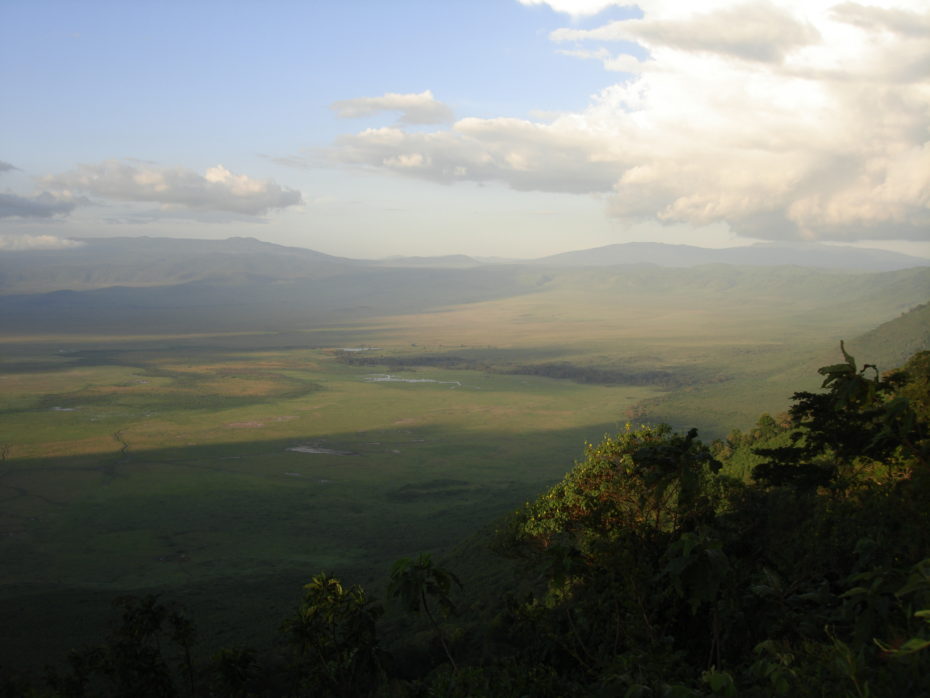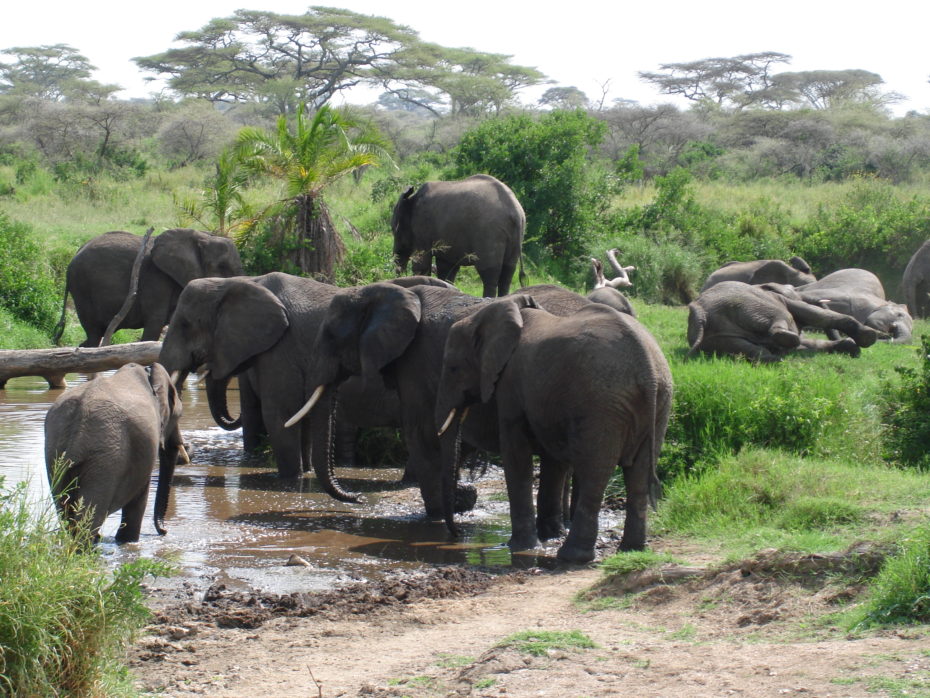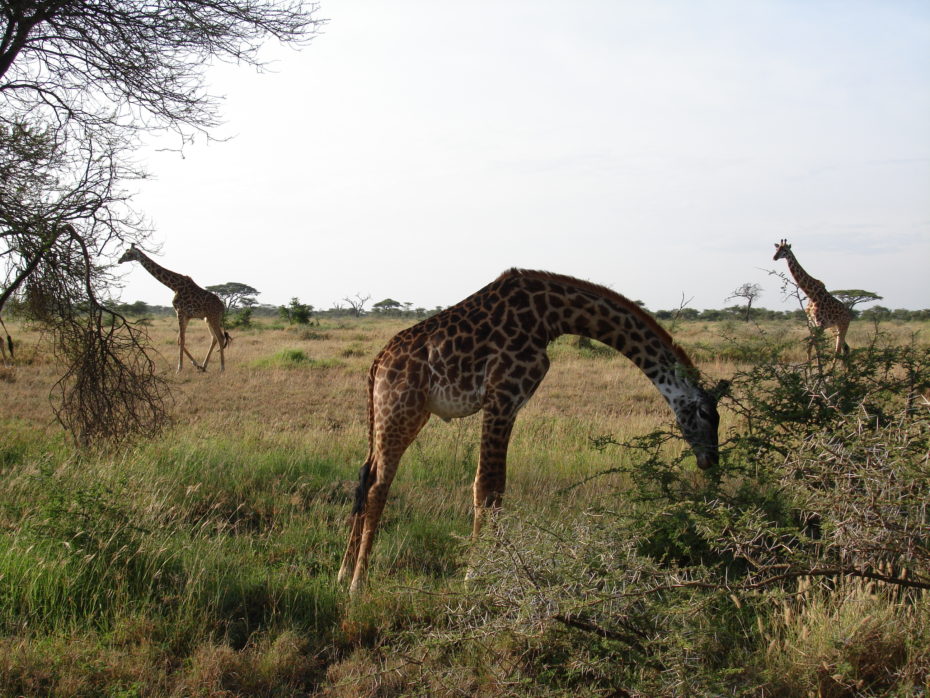I am sure most of you will have seen countless wildlife programmes over the years, undoubtedly many of these will have had footage of both the Ngorongoro crater and the Serengeti in the Masai Mara. It goes without saying that experiencing the animals in the wild is a great improvement on the telly.
First stop the Ngorongoro crater, even without the wildlife it would be worth the visit: A 20km wide caldera (essentially a massive volcano that blew its top leaving a big crater) with a 600m high crater rim, high enough to generate its own rain clouds which nourish the area’s flora and fauna. Blazing sun can bathe one part whilst a torrential downpour from a great, seething cumulonimbus cloud drenches another. The wildlife is so abundant it makes the safari parks of home seem like poor, sparsely populated imitations. Everywhere you look are animals: wildebeest, buffalo, elephants, zebra, lions, warthogs and rhinos. Thousands of flamingos on their pink, stilt, legs crowd around the dozing humps of hippos, whose lazy snorts and bubblings seem at odds with the fact that they manage to kill more people in Africa than any other animal. Obviously excluding the loathsome mosquito, whose disease bearing skills can make the AIDS pandemic look tame. Although the total bill for the three of us for the day was $350 we had nearly 10 hours of intense viewing, a bargain, especially considering that many of the encounters were at such a short distance from the car, not some indistinct speck in the binoculars. At no point was there a view without animals. The luckiest view of the day, although not particularly close up, was of three lionesses hunting warthogs. Even though their efforts ended in failure it was classic David Attenborough film material.
From the lush slopes of the Ngorongoro we bounced and rumbled our way over several hours of rough track to the Serengeti, pausing briefly at Olduvai gorge, the home to the archeological site of one of mankind’s earliest remains. We learnt, incidentally that it’s actually called Oldupai Gorge, obviously the first European to reach it and speak to the locals didn’t have his hearing aid in that week.
Masai Mara, the local name for this part of the Serengeti means endless plain, a highly appropriate nomenclature, for that is exactly what it appears as, sometimes a featureless expanse, at others filled with wildebeest and zebra stretching off into the heat haze horizon on both sides of the road. Whilst a landscape only one small step up from the Arctic in terms of things to look at may seem like a dull prospect, remember that coming from England’s rolling hills and inescapable signs of humanity such infinite views are truly a wonder.
Whilst safari drives in the Serengeti meant a certain amount of time looking but not seeing any wildlife, this was more than made up for by the close up meetings with herds of giraffes and elephants, besides, the view made a pleasant change from the usual one from the 50A bus into town back home.
Everyone has their favourite safari animal and for me it was the giraffe whose stately, elegant walk countered their apparent fragility and reminded me of the Walking with Dinosaurs programmes, where herds of giant, animated herbivores grazed over Jurassic plains. They may not have the obvious appeal of elephants or lions whose exploits have been done to death on the TV but this may have given them, with their docile, quizzical looks a more otherworldly appearance. The prize for the cute and cuddly encounter had to go to a pair of cheetah cubs – everyone say “ahhhhhhh” in a soppy voice. We can only hope that mum came back from her hunting expedition to retrieve them.
Although TV nature programs may rejoice in shots of angry beasts charging cars and threatening cameramen, most animals remained largely unconcerned by our presence. Apart from a roar from a lion, when there was a brief moment of apprehension that standing in an open top Toyota Landcruiser may not be the safest place to be, the remainder of the wildlife offered only the mildest curiosity at our presence.
Although Tanzania’s animals exceeded all expectations the same cannot be said for some of its human population. I will not stoop so low as to tar them all with the same brush because we have met plenty of genuine, honest and kind hearted people here. However I have never been so repeatedly ripped off, overcharged and treated with such little respect in cafes and shops as I have here. The odd example would not bother me as it can happen anywhere, as I am sure many visitors to England will attest. Neither do I object to a “tourist tax” ie: paying a bit more than the locals would, after all it’s a poor country and as relatively rich westerners it would be uncharitable to begrudge people a modest bonus for their efforts. All the same I would rather pay this as a generous tip for a good and pleasant service. The blatant rip offs have become sufficiently numerous to annoy me in a way that no other country has. Being charged 5 times the going rate is especially galling after being given a speech about love, peace and harmony or how black and white are all the same. When buying things I will happily bargain as hard as necessary if it is required, without arguing the toss over some small sum but to be asked to pay $150 for 3 cd’s that a local would pay about $10 just says that they are treating us muzungus (Swahili word for white people) with no respect and are just a source of cash to be exploited. I have been to far poorer countries and treated far better for which I am only too happy to reward. Too some extent we have all resisted buying things because of the dislike of the possibility of entering into such a squalid process. A notable exception were Muslim run businesses, where the bill always matched the clearly marked prices on the menu.
I have noted that there is a greater tendency to the rip off mentality in the more established tourist industries, Syria and Iran for example, hardly top tourist destinations were refreshingly fairly free of it, so I am sure that away from the safari circuit Tanzania is not so prone. Ironically our two uses of taxi drivers, often a detestable breed of tourist vulture didn’t even require haggling with to get a sensible price.
Being in the lively town of Arusha the Saturday before departing it seemed only right to sample the delights of one of the local night clubs, purely in the interest of anthropological and cultural studies you must understand. The Colobus club, with one of its rooms devoted solely to East African and Congolese music we had more fun dancing in, being freed from the more unpalatable aspects of US R&B. The dancing was even dirtier than the earlier experience of clubbing in Rwanda and we entertained ourselves by fending off the local prostitutes, though it has to be said that Chris did a lot less fending off than Ash or I. Whilst none of us would win prizes for dancing we acquitted ourselves better than two of the other handful of muzungus whose approach consisted of self conscious, erratic lumberings whilst staring at girls’ breasts in the strange belief that they might find this alluring. Let me assure you that need be no reader of subtle body language to determine if the local ladies are interested in you, if they are you have to peel them off yourself. A fact oblivious to these two oafs. Anyway, we put in a respectable 5am showing on the dance floor before brushing aside final discount offers of pleasure from the “designer ladies”, as our taxi driver called them and headed home.







